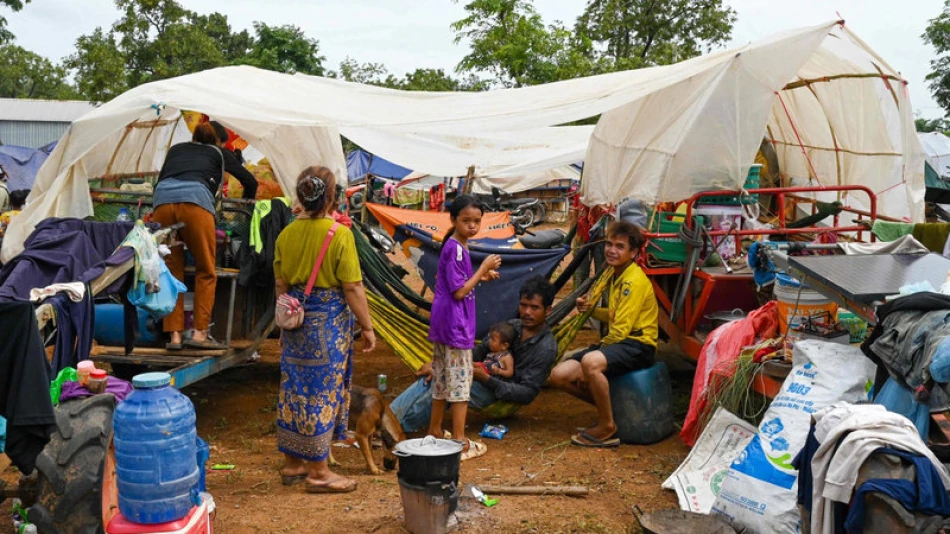
Tensions Flare: Thailand and Cambodia Exchange Shelling Despite Trump's Ceasefire Call
Cambodia-Thailand Border Clashes Escalate Despite Trump-Mediated Ceasefire Talks
Artillery exchanges erupted between Cambodian and Thai forces across disputed border territories early yesterday morning, just hours after US President Donald Trump announced that both nations' leaders had agreed to pursue a ceasefire. The renewed violence underscores the fragility of diplomatic interventions in Southeast Asia's most persistent territorial dispute, threatening regional stability and exposing the limits of external mediation in centuries-old conflicts.
Diplomatic Efforts Meet Military Reality
The timing of the clashes reveals the gap between high-level diplomatic commitments and ground-level military dynamics. Cambodia expressed full support for Trump's immediate ceasefire call, while Thailand acknowledged the US President's initiative but insisted it cannot begin negotiations while Cambodian forces allegedly target Thai civilians—a claim Phnom Penh categorically denies.
Thai Acting Prime Minister Bhumtham Wetchayachai outlined Thailand's position before visiting border areas: "We require no third-party interference, but we are grateful for his initiative." Thailand has proposed foreign minister-level talks to finalize ceasefire terms and withdraw long-range weapons and forces.
Escalating Military Actions
Both sides blame each other for initiating yesterday's hostilities. Cambodia claims Thailand deployed forces along the border and launched the attacks, while Thailand maintains it was responding to Cambodian aggression. The Cambodian Defense Ministry reported Thai bombardment and ground attacks on multiple positions, including heavy artillery fire on temple complexes. Thailand's military confirmed deploying long-range rocket launchers after alleged Cambodian strikes near civilian areas.
Humanitarian Crisis Deepens
After four days of the most intense fighting between the Southeast Asian neighbors in over a decade, casualties have exceeded 30 deaths—13 Thai civilians and 8 Cambodians among them. More than 200,000 people have been evacuated from border regions, creating a humanitarian emergency that threatens to destabilize local economies and cross-border trade.
The civilian toll highlights how this territorial dispute transcends military posturing, directly impacting communities whose livelihoods depend on cross-border commerce and agriculture. The mass displacement represents the largest population movement in the region since the 2008-2011 border tensions.
Historical Context and Root Causes
The current crisis stems from decades-old disputes over unmarked sections along the 817-kilometer land border. The conflict centers on ownership of two ancient Hindu temples—Ta Moan Thom and Preah Vihear—dating to the 11th century. These sites represent more than territorial claims; they embody national identity and historical legitimacy for both nations.
Tensions escalated following the death of a Cambodian soldier in late May during brief skirmishes. Both governments subsequently reinforced border positions, creating a military standoff that has pushed Thailand's fragile coalition government toward potential collapse.
Regional and Global Implications
This conflict tests ASEAN's conflict resolution mechanisms and exposes the bloc's limitations in managing member state disputes. Unlike the South China Sea tensions where external powers play clear roles, the Cambodia-Thailand border dispute remains primarily bilateral, making resolution more dependent on direct negotiations.
Trump's intervention, while diplomatically significant, reflects broader US interests in maintaining Southeast Asian stability amid China's growing regional influence. However, the continued fighting despite American mediation efforts suggests that external pressure alone cannot resolve deeply rooted territorial disputes.
Economic and Strategic Stakes
The border closure disrupts crucial trade routes and agricultural supply chains between the two countries. Thailand's tourism industry, already recovering from various challenges, faces additional pressure from regional instability. For Cambodia, the conflict threatens development projects and foreign investment confidence in border provinces.
The temple sites themselves hold significant tourism potential, making their control economically valuable beyond symbolic importance. Resolution of ownership could unlock joint tourism development opportunities, transforming conflict zones into economic cooperation areas.
Path Forward Remains Uncertain
Despite diplomatic initiatives from the US and Malaysia, the fundamental territorial dispute remains unresolved. The proposed foreign minister meetings represent a potential breakthrough, but success depends on both sides' willingness to make territorial concessions—historically the most difficult aspect of these negotiations.
The international community's response will likely focus on humanitarian assistance and diplomatic pressure rather than military intervention. However, prolonged conflict could draw in other ASEAN members as mediators, potentially internationalizing what both countries prefer to keep bilateral.
 Sara Khaled
Sara Khaled







